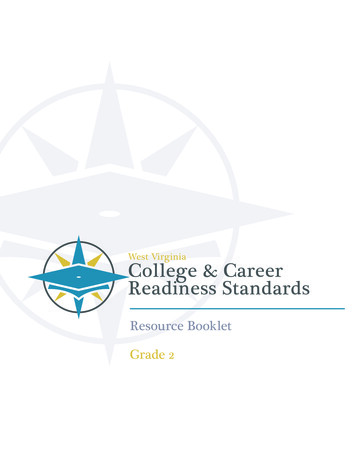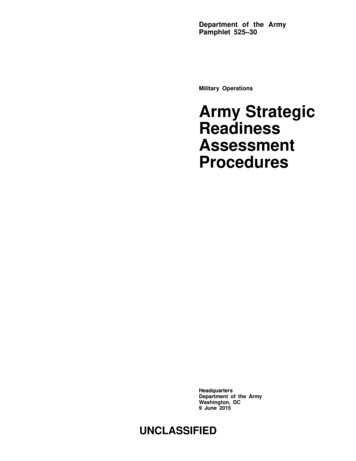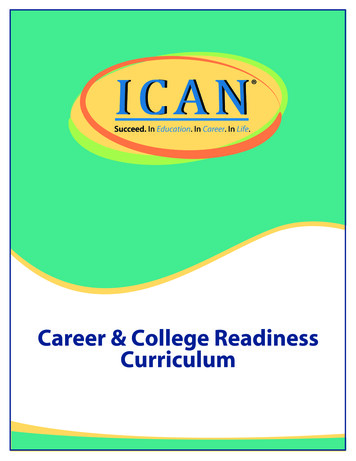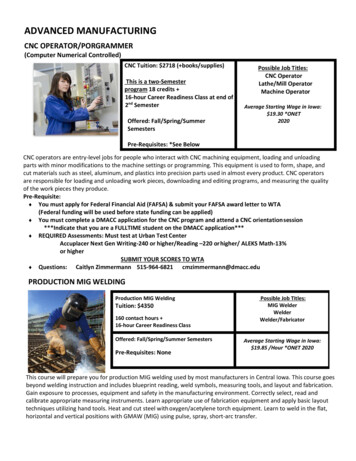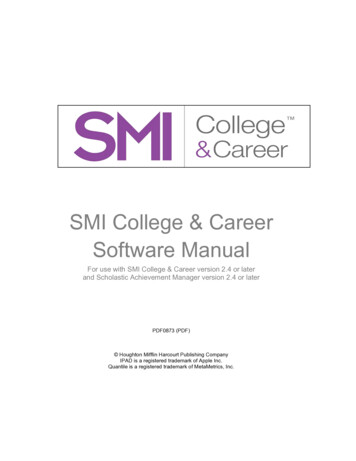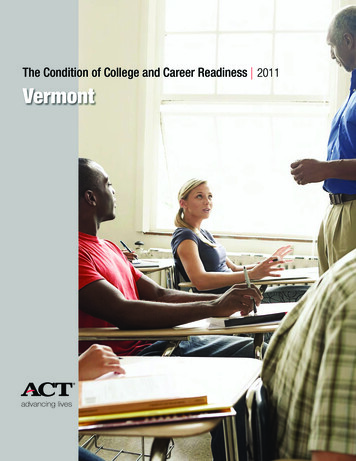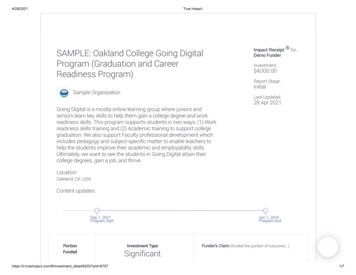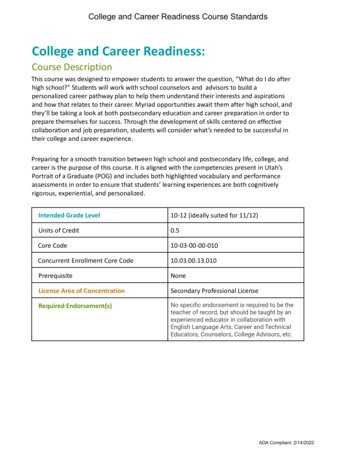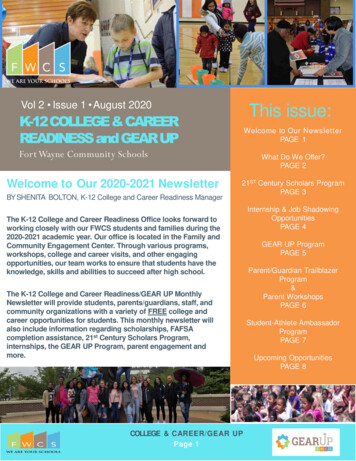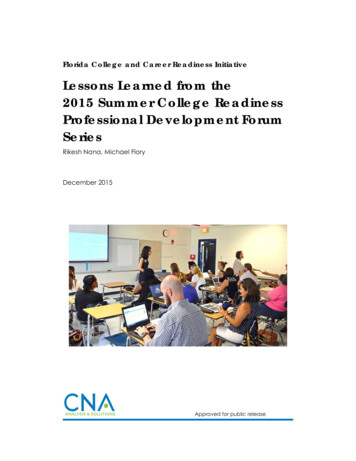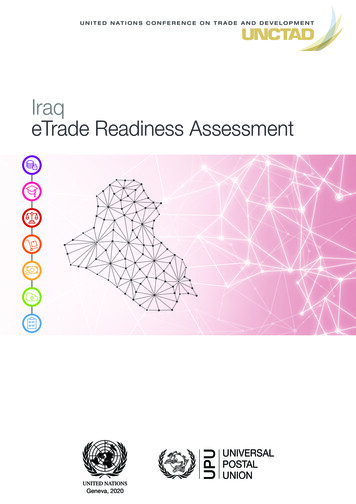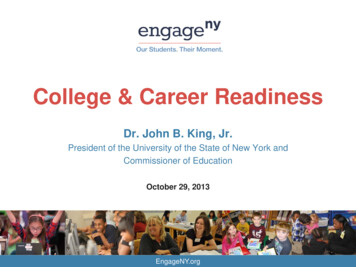
Transcription
College & Career ReadinessDr. John B. King, Jr.President of the University of the State of New York andCommissioner of EducationOctober 29, 2013EngageNY.org
Graduating College andCareer Ready - StatewideNew York's 4-year high school graduation rate is 74% for All Students.However, the percent graduating college and career ready is significantly lower.June 2012 Graduation RateGraduation under Current RequirementsCalculated College and Career Ready*% Graduating% GraduatingAll Students74.0All Students35.3American Indian58.5American Indian18.8Asian/Pacific Islander81.6Asian/Pacific 15.7White85.7White48.5English Language Learners34.3English Language Learners7.3Students with Disabilities44.7Students with Disabilities4.9*Students graduating with at least a score of 75 on Regents English and 80 on a Math Regents, which correlates withsuccess in first-year college courses.Source: NYSED Office of Information and Reporting ServicesEngageNY.org2
Graduating College and Career Ready –New York CityThe 4-year high school graduation rate in New York City is 60.4% for All Students.However, the percent graduating college and career ready is significantly lower.June 2012 Graduation RateGraduation under Current RequirementsCalculated College and Career Ready*% Graduating% GraduatingAll Students (NYC)60.4All Students (NYC)21.9American Indian48.2American Indian13.9Asian/Pacific Islander79.1Asian/Pacific 12.2White75.1White39.1English Language Learners35.4English Language Learners8.5Students with Disabilities27.6Students with Disabilities1.7*Students graduating with at least a score of 75 on Regents English and 80 on a Math Regents, which correlates with success in firstyear college courses.Source: NYSED Office of Information and Reporting ServicesEngageNY.org3
Domains of College and Career ReadinessDefines the academic knowledgeand skills students need to besuccessful in college andcareers.Specifies the noncognitive, socio-emotionalknowledge and skills thathelp students successfullytransition from high school tocollege or careers.Describes the careerspecific opportunitiesfor students to gain theknowledge, skills, andcompetencies they needto pursue and succeed in theirchosen career.EngageNY.org4
Converging Evidence aboutCollege ReadinessCollege andCareer ReadinessWhether the measure isnational or New Yorkspecific, at theelementary/middle orsecondary level, there isconverging evidence aboutstudent preparedness forcollege and careers.EngageNY.org5
NAEP & College Readiness New studies on a 12th grade NAEP assessment,administered in 2009, suggest NAEP proficiencypredicts ‘college preparedness.’ Nationally, in 2009: 38 percent of 12th graders scored at or aboveproficient in reading26 percent reached proficiency in math“When college and career readiness is on everyone’s lips, . lo and behold,the pretty-clear conclusion reached is NAEP ‘proficient’ comes pretty darnclose to college preparedness” Chester Finn, Former Chair, National Assessment Governing Board; Current President, Thomas B. Fordham InstituteSource: EdWeek, 8/15/2013 b.h33.htmlEngageNY.org6
New York 2011 NAEP Reading31%41%4%9%24%26%33%32%Grades 4 and 8Grade 4Level 1Grade 8Level 2EngageNY.orgLevel 3Level 47
New York 2011 NAEP Math5%7%23%20%30%31%40%44%Grades 4 and 8Grade 4Level 1Grade 8Level 2Level 3EngageNY.orgLevel 48
SAT and PSAT Benchmarks forNew York Students College Board and NAEP study determined scoreson SAT and PSAT/NMSQT that correspond withcollege readiness for the nation. Criteria were adapted slightly to accommodateNew York students’ course-taking patterns. The results for all New York students whograduated in 2010 and who took the SAT andPSAT/NMSQT are on the following slide.EngageNY.org9
SAT and PSAT/NMSQT CCRBenchmark Data: ELAEngageNY.org10
SAT and PSAT/NMSQT CCRBenchmark Data: MathEngageNY.org11
Why Readiness Matters –Labor Market Is More DemandingA post-secondary education is the“Passport to the American Dream” Of the projected 47 million job openings between 20092018, nearly two-thirds will require workers to have atleast some post-secondary education – and experts saythis percentage will only increase. 14 million job openings will go to people with anassociate’s degree or occupational certificate and pay asignificant premium over many jobs open to those withjust a high school degree.Sources: Pathways to Prosperity Project, Harvard University, February 2011; Georgetown Center on Education and the Workforce, Help Wanted: Projections of Jobs and EducationRequirements Through 2018, June 2010.EngageNY.org12
Why Readiness Matters –Earnings and UnemploymentUnemployment Rate By Degree: 20112.4%Doctorate2.5%Professional Degree3.6%4.9%6.8%8.7%9.4%14.1%Average 7.6%Median Annual Earnings by Educational Degree: 2011 86,580 80,652Masters 65,676Bachelors 54,756Associate 39,936Some College, No Degree 37,338HS Diploma 33,176No HS Diploma 23,452Average 41,444Education pays in higher overall earnings and lower unemployment rates.SOURCE: 2011 Bureau of Labor Statistics, Current Population SurveyEngageNY.org13
Why Readiness Matters –Underperformance Costs 1 Trillion America’s urban school districts underperformcompared with their suburban counterparts. America’s suburban school districtsunderperform compared with theirinternational counterparts. If American students performed at the samelevel in math as Canadian students, we wouldadd 1 trillion annually to the economy.Source: Levine, Arthur. “The Suburban Education Gap.” The Wall Street Journal. 2012EngageNY.org14
Why Readiness Matters –Talent Dividend If New York increased its college attainmentrate by just one percent – from 33.8 to 34.8percent – the state would capture a 17.5billion Talent Dividend.Source: CEOs for CitiesEngageNY.org15
Why Readiness Matters –College Remediation in NYSOver 50% of students in NYS two-year institutions of higher education takeat least one remedial course.Remediation Rates for First-time, ll Institutions2-Year Institution4-Year InstitutionSource: NYSED Administrative Data for all Public, Independent and Proprietary 2- and 4-year institutions of higher educationEngageNY.org16
Regents Reform Agenda Implementing Common Core standardsand developing curriculum andassessments aligned to these standardsto prepare students for success incollege and the workplace. Building instructional data systemsthat measure student success and informteacher and principals how they canimprove their practice in real time. Recruiting, developing, retaining, andrewarding effective teachers andprincipals. Turning around the lowest-achievingschools.Highly EffectiveSchool LeadersHighly EffectiveTeachersCollege andCareer ReadyStudentsEngageNY.org17
What is the Common Core? The development of the Common Core was anationwide, state-led effort to establish a shared setof clear educational standards. 45 states and the District of Columbia have adopted theCommon Core The Common Core Standards are the first learningstandards to be backmapped from the skills andknowledge students need to succeed in college andcareers, grade-by-grade all the way back tokindergarten. The Common Core Standards are benchmarked tointernational standards and informed by the bestevidence and research.EngageNY.org18
Common Core in New York2010: Board of Regents adopts Common Core2013: Common Core Assessments in Grades 3-8 andmath are administered2014: Roll-out of Common Core Regents Exams begins June 2014: ELA and Algebra IJune 2015: GeometryJune 2016: Algebra IIClass of 2017: First cohort of high school graduatesrequired to pass Common Core Regents Exams forgraduation.Transition to New York Common CoreAssessments is a seven-year phase in.EngageNY.org19
Aligning Curriculum, Instruction,and Assessments to theCommon Core Common Core curriculum, instruction, andassessments are rigorous and focus onpriority knowledge and skills to ensure Collegeand Career Readiness.6 Shifts in ELA/Literacy6 Shifts in MathematicsRead as much non-fiction as fictionLearn about the world by readingRead more challenging material closelyDiscuss reading using evidenceWrite non-fiction using evidenceIncrease academic vocabularyFocus: immersion in important topicsBuild skills across gradesDevelop fluency and accuracyReally know it, Really do itUse it in the real worldEfficiently solve complex problemsEngageNY.org20
Curricular Resources Professional Development Videos developedwith authors of Common Core and PBS Tri-State Rubric developed with Massachusettsand Rhode Island to evaluate district curricularmaterials against the Common Core Curricular Exemplars (sample lessons andinstructional materials) developed with feedbackfrom the authors of Common Core Sample Assessment Items developed withfeedback from the authors of Common CoreEngageNY.org21
Curriculum Modules Comprehensive, optional, free High-quality, rigorous, deeply aligned to theCommon Core Includes performance tasks and otherassessments which measure student growth –daily, weekly, at the end of each unit/module Ensures diversity of voices and perspectives intext selection Contains notes for teachers, templates,handouts, homework, problem sets, overviews Innovative creative commons license approachEngageNY.org22
EngageNY.orgResources for Professional DevelopmentNew and updatedParent and FamilyResourcesMost relevant andcurrent information,and newest materialshighlighted for easyaccess.One-stop location forresources andmaterials to supportimplementation of theRegents ReformAgendaEngageNY.org23
Common Core Instructional VideosEngageNY.org24
Network Team InstitutesProfessional Learning Experiences for: Teacher and Principal “Ambassadors” District Staff Coaches Network TeamsEngageNY.org25
Toolkit for Parent EngagementEngageNY.org26
Myths about the Common CoreMythRealityThe Common Core arenational standards beingimposed by Washington.The Common Core began as a collaborative effortof the National Governors Association and theCouncil of Chief State School Officers. Teachers,parents, school administrators and experts fromacross the country together with state leadersprovided input into the development of thestandards.The Common Core aretoo challenging andrigorous.We have an obligation to prepare students forsuccess in college and careers in the 21st Centuryglobal economy. We need to challenge students andprovide feedback on progress beginning in the earlygrades, while there is still time to intervene.The Common Core wererushed and districts andteachers wereunprepared forimplementation.The Board of Regents first adopted the CommonCore in 2010. Educators throughout the state haveworked hard to prepare teachers and students forthe new standards, and they are rising to thechallenge.EngageNY.org27
Teachers, Students, and ParentsNeed Clear Expectations andMeasures of Progress The assessment program is a key tool tosupport improved teaching and learningoKey measure of how students aredoing on NYS Learning StandardsoCritical component of the State’saccountability systemoContribute to our evaluation ofteacher and principal effectiveness The assessment program helps usdemonstrate to parents that their childrenare meeting rigorous expectations as theyprogress through our education system. The assessment program provides acontinuous feedback loop to parentsand educators so they can bettersupport student learning.EngageNY.org28
Testing Under NCLB The federal No Child Left Behind (NCLB) Act requires, among othermeasures, administration of the following assessments:ooo Grades 3-8 English Language Arts (ELA) & Mathematics examsAt least one Science exam in Grades 3-5, 6-9, and 10-12At least one High School ELA and Mathematics examThe Grades 3-8 ELA and Mathematics, Grades 4 and 8 Science, andHigh School English and Mathematics assessments were used by NewYork, together with graduation rates, to hold schools and districtsaccountable for student results.oSchools and districts were identified as being in Good Standing, In Need ofImprovement, Corrective Action, or Restructuring based upon whether theyachieved Adequate Yearly Progress (AYP) on assessments.EngageNY.org29
ESEA Waiver The Department’s ESEA Waiver was acceptedby USED in May 2012. Key components of the Waiver include: Implementation of College and Career Ready Standards;Teacher and principal evaluations that incorporatemeasures of student growth;Use of growth in addition to absolute performance to makeaccountability decisions; andDesignation of the highest-performing schools in the stateas Reward Schools.EngageNY.org30
Testing Schedule – ELA20122013English Language ArtsEnglish Language ArtsGradesEstimatedTime forCompletion*TimeScheduledGradesEstimatedTime forCompletion*TimeScheduled3-570, 60, 45minutes90, 90, 90minutes3-450, 50, 50minutes70, 70, 70minutes6-870, 60, 50minutes90, 90, 90minutes5-870, 70, 50minutes90, 90, 90minutesThe Department has designed testing times to allow studentssufficient time to demonstrate what they have learned. This broughtNew York closer to the schedules issued by other highly-regardedassessment systems which ask schools to schedule longer blocksthan the expected testing time.Note: Estimated Time for Completion and Time Scheduled per book.EngageNY.org31
Testing Schedule - imatedTime forCompletionTimeScheduledGradesEstimatedTime forCompletionTimeScheduled360, 60, 50minutes90, 90, 90minutes350, 50, 50minutes70, 70, 70minutes4-860, 60, 60minutes90, 90, 90minutes450, 50, 70minutes70, 70, 90minutes5-850, 50, 70minutes90, 90, 90minutesThe Department has designed testing times to allow studentssufficient time to demonstrate what they have learned. This broughtNew York closer to the schedules issued by other highly-regardedassessment systems which ask schools to schedule longer blocksthan the expected testing time.Note: EstimatedTime for Completion and Time Scheduled per book.EngageNY.orgEngageNY.org32
Common Core Assessment DevelopmentEvery item: Designed from scratch to measure Common Core Field-tested Reviewed multiple times in development cycle bymultiple New York State Certified Teachers Meets industry best practice for item quality, fairnessand accessibility Meets rigorous criteria developed by NYSEDProcesses and quality assured by HumRRO, a thirdparty evaluator also used for the NAEP.EngageNY.org33
Independent Review In order to better ensure the quality of ourassessments, the Department asked HumRRO toconduct a number of independent analyses to reviewand improve the quality of test questions andscores. The study’s overall conclusion is that the processesused by our contractor to develop and review itemsare thorough and fully meet or exceed industrystandards.EngageNY.org34
Just as New York Educators areEssential to Test Development New York educators are represented on the following panels: New York State Content Advisory Panels Spans early childhood and P12 through CUNY, SUNY and cIcu facultyItem Development, Item Review, Final Form ReviewThese panels are informing: College and Career Ready Determinations Test specifications, policies, and items Policy-level and grade-level performance leveldescriptions EngageNY.org35
New York Educators areEssential to Setting Standards 95 New York educators for Days 1 to 4 34 stayed for Day 5 Variety of educators nominated and represented: K-12 ELA and Math TeachersBOCESELL and SwD specialistsHigher EducationK-12 Administration Panelists represented New York’s geographic anddemographic diversityEngageNY.org36
Setting Performance Standards forCommon Core AssessmentsCommon CoreStandards / CCRResearch-basedMethodologyNY EducatorJudgmentCutScoresStandard SettingDeterminationEngageNY.org37
A New Baseline This year’s grades 3-8 ELA and math proficiency percentagesshould not be compared directly with prior-year results. Unlike prior years, proficiency is now based on theCommon Core – a more demanding set of knowledge andskills necessary for 21st century college and careers. These results present a new and transparent baseline fromwhich we can measure student progress and preparedness forcollege and careers. School and district leaders are urged to be thoughtful to ensurethese proficiency results have no negative impact on students,schools, districts, or teachers. No new districts will be identified as Focus Districts and no newschools will be identified as Priority Schools based on 2012-13assessment results.EngageNY.org38
In ELA, 31.1% of students in grades 3-8 across the State met or exceeded theproficiency standard (NYS Levels 3 or 4), reflecting a new baseline relative tothe Common Core StandardsThe vertical lines indicateyears where changeswere implemented. In2010, cut scores changed,but the standards andscale remained the same.In 2013, the standards,scale, and cut scoreschanged to measure theCommon Core.77.4%53.2%55.1%52.8%31.1%Grades 3-82009201020112012EngageNY.org201339
In math, 31.0% of grades 3-8 students across the State met or exceeded theproficiency standard (NYS Levels 3 or 4) in math, reflecting a new baselinerelative to the Common Core Standards31.0%61.0%63.3%64.8%86.4%The vertical lines indicateyears where changeswhere implemented. In2010, cut scoreschanged, but thestandards and scaleremained the same. In2013, the standards,scale, and cut scoreschanged to measure theCommon Core.Grades 3-8 Math200920102011EngageNY.org2012201340
Materials to Support ScoreInterpretation and UseReleasedAnnotated Items Select Items from 2013 Tests withannotationsPerformance Descriptions of the knowledge and skillsLevel Descriptions required for each performance levelAppropriate Use Suggested analysis of test score data toof Test Score Data further interpret student performanceAnnotated ScoreReport Annotated score report to help parentsand students interpret scoresEngageNY.org41
Also Key background information for principals andteachers to share when talking with families andthe community about the results Letter to Parents and Families about the 2013scores as a new baseline Resources for Parents and Families (includingmaterials for workshop on Common Core)EngageNY.org42
Assessment Resources on EngageNY.org Test Guides One for each grade and subject Sample Questions Annotated for educator use in classroom Assessment design criteria Passage-selection criteria Design criteria for Common Core questionsNew York State has never been more transparentabout what content and skills are measured on ourassessments and how they are measured.EngageNY.org43
Common Core Regents ExamsEngageNY.org44
Myths about AssessmentsMythThe new assessmentshave led to “teaching tothe test.”RealityTo the extent that there has been any teaching tothe test, it has been against the guidance of theDepartment, which has advised districts against rotetest prep practices.Tests do not contribute to When results are properly analyzed and applied,instruction.they can be one of multiple measures to helpteachers provide tailored supports and instruction.We have more tests than Much of the assessment program is mandated byever before.NCLB and has been in place for many years. Theremay have been additional assessments negotiatedlocally as part of the implementation of evaluationsystems.EngageNY.org45
Partnership for Assessment ofReadiness for College and Careers(PARCC) Technology readiness is a challenge, but schools arealready making investments in technology to supportinstructional goals. PARCC will offer a computer-based, innovativeassessment system to measure student performance onthe Common Core standards. The assessments will provide data to inform instruction,interventions, and professional development. The assessments will determine whether students are ontrack to college and career readiness in math andELA/Literacy. PARCC adoption is dependent on Board of Regentsapproval.EngageNY.org46
Educational TechnologyThat Supports Teaching and LearningAssessmentsActionCulture .orgAnalysis47
Educational Technology Guiding Questions Can educational technology tools help supportteaching and student learning? Can we invest in a system that providesdistricts and schools with more educationaltechnology options at lower costs and allowsthem to improve the system to meet localneeds? How do we improve data security and privacyprotocols when districts, schools andBOCES/RICs contract with third partyeducational technology vendors?EngageNY.org48
Current and Past Practices Data systems support our core mission to providehigh quality education services. Consistent with FERPA, New York has a statewidestudent database in place and provides thisinformation to third parties as necessary to meet itsprogram evaluation and improvementresponsibilities (e.g., school report cards) Consistent with FERPA, districts and schoolsprovide data to third parties to meet theirinstructional and organizational responsibilities Student enrollment, schedules, report cards, transcriptsSpecial education servicesSchool lunch and transportationOnline learning and formative assessmentEngageNY.org49
Goals of the EngageNY Portal(ENYP): Secure and private data tools foreducators, students, and families Easy access to Common Core curriculumand instruction resources (EngageNY.org) Online communities for educators Ability for LEA’s, BOCES, NYSED, orthird-parties to more effectively improveand add to the system following initialState investmentsEngageNY.org50
Data Privacy and Security Improving data security and privacy is aprimary goal The biggest risks to data security and privacyinclude: unattended paper records,unattended computers, weak passwords, datasent via plain text email, etc. Local and State data stored through inBloomreceive double protection – intrusionprotection (firewall) and encryption protection ENYP will leverage statewide securityprotocols to ensure only the right people viewthe right dataEngageNY.org51
Data Privacy and Security As is currently the case, states/districts retainownership of all data As is currently the case, data are never redisclosed to a third-party, including vendors,without state/district approval As is currently the case, data will be receive allfederal and state security protections,including FERPA As is currently the case, data are separatefrom other states and districts (no nationaldatabase)EngageNY.org52
inBloom inBloom is a non-profit provider of open, nonproprietary, and standardized services to supportdata security, storage, access, and transport Without a service like inBloom’s, security protocolsvary, and districts pay twice for educationaltechnology tools – once for the tool and once tomake the tool work with local district systems inBloom services allow tools to be built to standard(will work “out of the box”), increasing security,options and lowering costs Because all is open and non-proprietary, inBloomcould be replaced with different service providers inthe futureEngageNY.org53
Myths about EducationTechnology SupportsMythRealityMy student’s data is beingsold to private companies.School districts routinely contract with private vendorsfor data supports critical to the districts mission,consistent with FERPA.* These data are not sold toprivate companies. Districts are required to havenotification and opt-in/out policies if data are to beshared for non-mission critical purposes.Social security numbersare collected.The Department does not – and does not intend to –collect social security numbers.Confidential records will bedisclosed and it willprevent my child fromgetting into college orgetting a job.Student or parent consent is required for the transfer oftranscript data. Electronic transfer of authorizedtranscript data holds the potential to help facilitate thecollege admissions process for students and families.*The Family Educational Rights and Privacy Act is a federal law that protects the privacy of student education records. FERPA allows schoolsto disclose records without consent under certain conditions, including but not limited to, school officials with legitimate educational interest.EngageNY.org54
Regents Reform Agenda Implementing Common Core standardsand developing curriculum andassessments aligned to these standardsto prepare students for success incollege and the workplace. Building instructional data systemsthat measure student success and informteacher and principals how they canimprove their practice in real time. Recruiting, developing, retaining, andrewarding effective teachers andprincipals. Turning around the lowest-achievingschools.Highly EffectiveSchool LeadersHighly EffectiveTeachersCollege andCareer ReadyStudentsEngageNY.org55
More Education More Opportunity Having a collegedegree means thatchildren born intothe middle threeincome quintilesare more than 75%more likely toadvance to ahigher incomequintile as adultsthan those who donot get a collegedegree.Source: Brookings analysis of the Panel Study of Income Dynamics. Retrieved from The Economic Case for Higher Education, Ed.gov BlogEngageNY.org56
Thank You.Follow me on Twitter:@JohnKingNYSEDEngageNY.org
Career Ready - Statewide New York's 4-year high school graduation rate is 74% for All Students. . The 4-year high school graduation rate in New York City is 60.4% for All Students. However, the percent graduating college and career ready is significantly lower. . New studies on a 12 th grade NAEP assessment,
